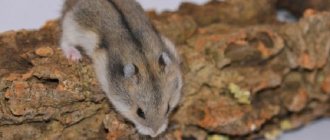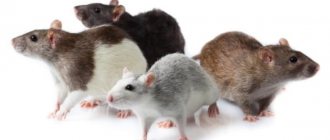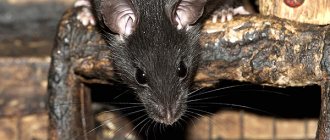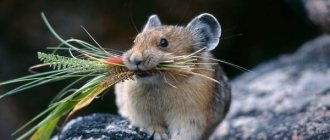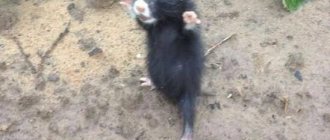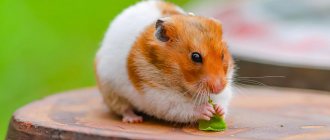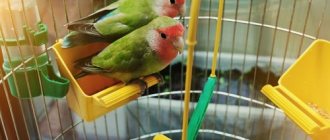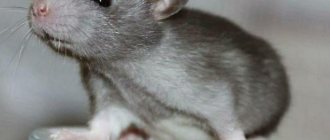A wild, field hamster is one of the representatives of the hamster family, living freely in its natural habitat. Outwardly, it very much resembles a domestic hamster.
The rodent is widespread everywhere. This unpretentious animal can be found in the steppes, mountains and forests. The rodent is not afraid of being close to humans, so it often settles in garden plots and vegetable gardens. The wild hamster has other names - “karbysh”, “garden hamster”, “garden hamster”, “field hamster”. Translated from the Avestan language, the name of this animal means “enemy who overthrows the earth.”
Data on wild representatives
There are 19 known species of the hamster family, belonging to mammals and rodents. There are 12 species in the country, classified into 6 genera, including:
- real;
- average;
- gray;
- hairy legs;
- rat-like;
- Eversmannov.
They have distinctive features in their appearance that allow them to be classified. By the way, the largest representative of the family in the world reaches a length of 34 centimeters, which indicates its truly impressive size.
Description of appearance
On the territory of the country there are hamsters that differ in certain external characteristics:
- from the true genus - weighing up to 500 g, yellowish-brown color, with black and white markings on the sides, distinguished by small ears, paws that look like human hands;
- from the genus of hairy-footed animals - weighing up to 30 g, sandy color with golden tint veins, there are whitish spots on the fur in the eye and abdominal area, large ears, located vertically, on the muzzle there is a kind of angular “mask” of a whitish tint;
- from the genus rat-like - weighing up to 240 g, the color is grayish-brown, turning into white in the abdomen, the tail looks like a rat's, is covered with fluff and has a whitish tint at the tip.
Almost all representatives of the hamster family living in the wild, belonging to the male sex, are significantly smaller in size than females. Hamsters are naturally endowed with four sharp teeth that do not have roots and are constantly growing. Animals have to constantly grind them down on stones.
Habitats
When trying to understand where cute creatures live in nature, it is worth understanding: the habitat is determined by belonging to a certain species. They are found in the Russian Federation, China, Mongolia, South Korea, Iran, and Syria. It is not necessary to go on a long journey to meet representatives of the class of mammals; it is enough to have information about the features of their external appearance to determine rodent settlements in landscapes close to human lands.
"Steppe People"
Another name for the steppe hamster family is ordinary; they differ significantly in appearance from their domesticated relatives. Males of this species are distinguished by increased aggression, directed at other males during the breeding season, animals much larger than them.
Representatives of the hamster family are predominantly nocturnal; their burrows are located at a depth of 8 meters and can reach 90 meters in length. It is important that this is a fairly clean animal: having excavated its hole, people find a kind of storage room, a “bedroom”, and even a toilet.
Typically, the territory patrolled by males is 12 hectares. They patronize a pair of female representatives of the species, intercourse with them during the breeding season. Joint burrows between females with cubs and males were not observed where individuals live in large numbers.
"Lesoviki"
Representatives of the forest species are rarely found in the forest belt. They do not need to have a large number of trees to arrange their own home. Zoological scientists noted data on their habitat in the forests of North America, deserts and prairies. On the territory of our country, this species is usually found near human habitations.
There is no specific way of life observed among forest hamsters. Males and females can live together, separately. When the dwelling is located not far from a person, they go hunting at night. They do not dig holes, but strengthen their homes on tree trunks, camouflaging the latter with a large number of dry branches.
"Field workers"
In Russia, individuals of the field species are found in swamps; in other habitats it is almost impossible to find them. Their tail is covered with scales, and their appearance allows them to be confused with house mice and voles. They can reach 20 centimeters in length, and dwellings are usually built in reed thickets or on the stems of the plant itself.
This is interesting: What oceans wash the Russian coast?
Anatomy and appearance
Rodents in nature reach a size of 30-35 cm, body weight reaches 700 g. Females are smaller than males. The body is tightly knit and rounded, the neck is slightly pronounced. The head smoothly transitions into the body. The ears are short and rounded. The tail is short, up to 3-6 cm. At first it is thick, tapering towards the tip.
The front and hind legs are short. The claws are strong and well adapted for digging the ground. Hamsters' teeth gradually wear down and grow back throughout the animal's life. The fur is dense, with a thick undercoat. The predominant color is brown, with large white and black spots. There are animals of gray, sand and black colors.
Rodents have a dense, built-up body.
Their vision is poor, their hearing and sense of smell are well developed. Scent glands are located on the animal's body.
During its travels, the animal rubs its back against objects, leaving an odorous substance on them. Based on the smell, the animal can easily find its way home.
What does a common hamster eat?
The animal has an excellent appetite and is not picky about food, but plant-based food prevails in its diet. In the spring and summer, the hamster loves to feast on insects and their larvae, and does not disdain small mice, reptiles, and amphibians (small vertebrates).
In autumn-winter, it switches to food from various types of seeds and tubers, the reserves of which are in sufficient quantities (from 0.5 to 16 kg) in its bins. In some cases, storerooms with supplies up to 90 kg were discovered.
Familiarize yourself with the features of keeping such popular breeds at home as the Siberian, Roborovsky, Royal, Angora, and Campbell hamsters.
The granaries are dominated by grains of wheat, rice, millet, buckwheat, lentils, lupine, as well as potatoes, carrots, peas, and corn. The animal feeds on them during temporary wakefulness from hibernation and early spring until young green shoots appear.
Special pouches behind the hamster’s cheeks are designed for short-term storage of food. He is able to carry about 50 grams of grains (other food) to his home at a distance of more than a kilometer, supporting the bags with his front paws, and with them he takes food out of them.
Often the cheeks hang down to the animal’s shoulders due to the overfilling of the sacs. The hardworking, thrifty hamster also separates the grains by variety and puts each one separately.
The process of absorbing food occurs while sitting on its hind legs, and the hamster eats with its front legs: it stuffs food into one cheek, then the other, and quickly chews the contents.
Did you know? The common hamster is an excellent swimmer. The cheek pouches filled with air help him a lot when swimming.
Lifestyle and character
The animal is endowed with decent size and reaches the dimensions of a large rat. Leads a solitary, more twilight lifestyle, likes to make new passages in its burrow, and stores food for the winter.
He loves dry, sandy soils of steppes and forest-steppe areas, where it does not cost him much effort to dig underground passages in a hole. It is also often found in meadow and agricultural areas, and can adapt to existence in mountain areas.
In the cold winter, it hides in a deep burrow underground (where there are storage rooms and bedrooms) and hibernates, but can wake up to eat. For convenience, the hamster lines the burrow chambers with grass, which it replaces as it becomes dirty.
Living conditions in nature
Hamsters live on the ground. Cheek pouches help them swim across small bodies of water. They easily travel long distances in search of food or to create new homes. Here are a few facts that will help you understand the hamster's lifestyle:
- lives alone. The male and female spend a short time together during mating;
- stores a decent amount of food. Food allows him to survive winter and adverse weather conditions;
- falls into torpor or short-term hibernation when cold weather sets in. The animal is not prone to full winter sleep;
- active at night. This is how the rodent avoids attacks from terrestrial predators and birds;
- eats plant foods. They are not squeamish about eating insects and carrion. Large species prey on small animals;
- cautious and cowardly. The hamster's self-preservation instinct is well developed;
- protects his house from his relatives. If a fellow encroaches on the hamster's territory, a fierce battle begins. The defeated individual flees;
- females are good mothers , protecting their offspring until adulthood.
Attention! An interesting fact remains that Chinese peasants try to find a hamster pantry during lean times. People get from 10 to 20 kg of grain from one hole. The thrifty rodent has helped more than one family survive.
Nature has endowed hamsters with good hearing and the ability to make unusual sounds. Such features help the animals protect themselves from predators. Sharp teeth allow you to protect your territory from attacks by birds of prey and other rodents.
Important! Wild hamsters are carriers of dangerous viral and infectious diseases. Often people became victims of rabies and plague.
Lifespan
Wild animals have a life expectancy of 2 to 6 years, which distinguishes them from domestic pets. Some individuals can live up to 10 years. The period of existence depends on the amount of food stored and predators. Therefore, some individuals do not survive to one year of age. If the female does not have time to take her offspring to a safe place, then the entire family dies.
There are species that are on the verge of extinction. This is the Syrian and Newton's hamster. They are listed in the Red Book and live under supervision. Zoologists and scientists do not release them into the wild.
Nutrition
Hamsters are omnivorous animals, but they highly value vegetation. In summer they eat roots, greens, seeds, and insects. Large species of this family feed on small mice, lizards, and amphibians. In winter they eat reserves of grains, seeds, and vegetables. One individual is capable of accumulating up to 20 kg of food in the pantry. There were hamster “barns” where food supplies reached 90 kg.
Reproduction
The hamster reaches sexual maturity at two months of age. The male attracts the female with characteristic sounds. After the female has accepted courtship, the pair retires to a hole. Mating lasts from 20 to 24 hours. Then the female individual leaves the partner and bears the babies. After 17-20 days, offspring appear. Babies are born naked and blind.
One litter consists of 5-8 small hamsters. It is not uncommon for one baby or 18 tiny individuals to be born. Babies grow quickly. After a week, the body is covered with fluff, and after another 3 days it is covered with a full fur coat. The eyes open on day 14, and the hamsters begin to explore the world around them. During this period, they already become full-fledged, independent individuals. The instinct of self-preservation manifests itself, and they safely leave their native nest.
Only the mother ensures the safety of the children. If the adult feels danger, she moves the babies to a safer place. Transports them in cheek pouches.
The warm season allows one mother to bring 2 or 3 litters . Zoologists claim that there have been cases of babies being born in winter. The cubs of the first litter give birth to their offspring by the end of summer.
Lifespan
Typically, a hamster's lifespan ranges from two to six years. Individuals that have undergone domestication conditions can live longer, however, wild living conditions affect their life expectancy. Having caught the eye of predatory animals and being left without sufficient food supplies, rodents do not live to see a year.
Adaptation to survival in nature still prevents animals from dying on their own. There are babies on the verge of extinction, listed in the International Red Book. These include the Syrian hamster and Newton's hamster. At the moment, their cultivation is carried out under human supervision and they are not released into the wild.
Representatives of hamsters are distinguished by their unique hearing and the ability to make unpleasant sounds. This becomes their weapon in the fight against emerging predators. They often use their sharp teeth. The main thing for animals is to protect their territory of residence.
Video: forest hamster
Field
The natural habitat is marshy areas. Such hamsters carefully avoid such places. They have a scaly tail and appearance that can make them mistaken for common voles. The maximum length is 20 centimeters; they make their home in reed thickets or fasten plant stems.
Wild representatives
Modern science knows 19 species representing the hamster family. Only on the territory of the Russian Federation there are 12 species, divided into six genera:
- Real;
- Average;
- Gray;
- Hairy Legs;
- Rat-like;
- Eversmannaceae.
Each of them has unique external characteristics, thanks to which they can be classified. The largest of them reach a length of 34 centimeters. Some of them are found in Russia:
- Real ones. Weight is about 500 grams, yellow-brown in color, pronounced white markings are visible on the sides, small ears, paws shaped like human hands;
- Hairy-footed. They weigh no more than 30 g and have a sandy-golden color. Small white spots can be found on the face near the eyes and on the abdomen. The ears are large and stand upright;
- Rat-like. Medium size, weight up to 240 g, gray-brown color, turning white towards the belly. The tail resembles a rat's in appearance.
Almost all males are smaller than females. Rodents have four teeth, sharp enough to chew hard objects. Teeth do not have roots, and their growth does not stop throughout life.
What does a wild hamster look like?
The wild hamster has the following distinctive features:
- body length reaches 27-34 cm;
- average weight – 700 grams;
- muzzle of moderate length;
- the ears are relatively short, covered with thin dark hair;
- the tail is thick at the base, tapering towards the end, 3-8 cm long. Covered with short, stiff hair;
- the hand and foot are wide, the fingers have developed claws;
- limbs are short. Sometimes it seems that the hamster is crawling;
- The body hair is dense but soft.
The color of the animal is yellow or reddish-brown with black undercoat.
There is a black and white pattern on the body. The abdomen is black, on the sides there are light spots separated by black areas. There are light spots behind the ears, on the sides of the head (may be in the area of the shoulder blades). There are exclusively black specimens (melanists), some black with white spots on the paws and throat. The color becomes lighter in the direction from north to south within the range.
Did you know? According to the translation from the ancient Avestan language,
the word “hamster” means “an enemy who throws to the ground.” To pick up seeds, rodents bend plant stems to the ground.
Suitable home
Due to the fact that it is not recommended to walk the dzhungarika around the apartment, it needs a large and spacious cage. There should be enough space for walking and playing. There are several options for houses for dwarf rodents.
Cell
| Pros: | Minuses: |
|
|
Labyrinths
Houses with several compartments and passages between them resemble burrows. Mazes are usually more expensive than cages and aquariums, but they can be built gradually. Buy the main compartment first and then the top "room" and join them together.
Please note that for dwarf hamsters it is necessary that the compartments be connected by ladders. Toddlers can't climb up tunnels
If you decide to assemble such a house yourself from scrap materials, do not forget to make slits in the walls and ceiling. They will provide a constant flow of fresh air.
Aquarium house
Special plastic aquariums for rodents are great for dwarfs. Their small size allows them to make do with one-story dwellings. The main thing is that all the necessary accessories are there.
Where to put the cage?
Rodents feel good at the same air temperature as people. Do not place the cage in drafts or on a sunny windowsill. In addition, you should keep the cage away from:
- working battery;
- places with high humidity;
- TV;
- audio systems;
- other animals.
Do not place the house on the balcony (temperature changes, sun), in a draft (risk of colds), in the kitchen (not hygienic) and in the bedroom (rodents are active at night and make noise).
Cage equipment
What else will you need? The animal definitely needs:
- drinking bowl;
- Bowl;
- chalk stones or branches;
- nest (house);
- wheel;
- toys.
The ideal drinking bowl is the so-called dropper bottle. It needs to be hung away from the nest so that accidental drops do not wet it. Don't forget to change the water every day. Fresh water is the key to animal health.
It is better to place food in a heavy clay bowl so that the animal cannot turn it over. A hanging metal bowl will also work.
Chalk stones or branches are needed to point the teeth. Rodents' teeth grow throughout their lives, and if they are not taken care of, serious problems will begin.
In their natural habitat, rodents sleep in a separate compartment of their burrow. Try to create maximum comfort for him at home with the help of a small nest. Small wooden or plastic houses are suitable for this.
The wheel will help your pet get enough physical activity. Buy a solid wheel without slots or protrusions to protect the feet from fractures. Attach the wheel almost flush to the wall, otherwise the hamster may crawl between them and get stuck.
There are many toys for rodents at pet stores, but you can make many of them yourself. Excellent holes are made from cardboard toilet paper cylinders. Plastic rolling toys can successfully replace whole walnuts or hazelnuts. You shouldn’t fill the entire cage with toys – 1-2 is enough.
This is interesting: What running speed does a hyena develop?
Where does the Djungarian hamster live?
Photo: Djungarian hamster in Russia
The natural habitat of the dwarfs is quite wide. Djungarian hamsters are named after a province in the northwestern region of the People's Republic of China - Dzungaria.
Geographical regions of animal habitat:
- desert regions of Russia;
- Altai region;
- Kazakhstan;
- Mongolia;
- China;
- Korea.
The animals live in minks. The burrows are dug and arranged independently. Each burrow has from 3 to 6 entrances and exits. The structure of hamster burrows resembles real chambers, the depth of which is about one meter. The rodent has a pantry room where it prepares food supplies for the winter, a bedroom, and a latrine.
To keep an animal in artificial conditions, you will need a cage, which must be equipped with everything you need to keep a hamster comfortable. A wheel with a diameter of at least 16 centimeters must be placed in the cage. A wheel with a small diameter leads to spinal deformation. Another mandatory element is a house. It is better if it does not have large window openings to avoid an animal with cheeks full of food getting stuck in it.
It is necessary to put branches of fruit trees and shrubs in the cage, on which the hamster will sharpen his teeth. You need to designate a toilet for him in some corner. From time to time it is recommended to place a container in the cage into which sand can be poured for chinchillas. Djungarians will happily swim in the sand in this container. It is prohibited to place cotton wool, hay, or various scraps of fabric into the animals’ homes. Long fibers can crush the limb. In this case, it dies.
Protection from predators
The main means that saves a hamster from a sudden attack by a predator is the ability to react even to a barely audible sound from a great distance. The rodent is on alert from an unfamiliar sound.
If there is an opportunity to hide, the hamster immediately runs to its hole or to another secluded place.
If the sound comes suddenly, very close, and there is no time left to run and hide, the hamster freezes in the hope of remaining unnoticed. If this does not help, the last desperate step remains - an attack. The hamster takes a threatening position on its hind legs, makes aggressive sounds and uses its teeth, rushing at the enemy.
In addition to teeth, some types of hamsters have other means of defense. Thus, hamsters inhabiting the territory of the Panamanian highlands make sounds themselves to protect themselves from enemies and notify their relatives of possible danger. Thanks to this feature, these animals received the nickname “singing hamsters.” They also use these sounds to warn a rival hamster if it wanders into their territory.
Hamsters that do not hibernate and come to the surface have white fur to be invisible to predators.
Now you know that a hamster is not only a cute and funny animal that children love so much. In the wild, a hamster is a dangerous and serious animal that can hunt other animals and is even capable of repelling a predator.
What I am a master at is talking incessantly about hamsters. I have three hamsters at home, and my husband has a pet rat. That’s how we live, the six of us eat, the six of us sleep :)
Post Views: 2,737
Interface used
Another type of classification is the interface used to connect the manipulator to the computer.
There are three types of mice:
PS/2.
They are connected via a round five-pin plug into the corresponding socket on the motherboard (usually marked green). The disadvantage is that after reconnecting the device, the computer does not respond to it, so a restart of the operating system is required.
USB.
A more advanced interface that allows you to change the mouse on the go or use several mice at the same time.
Wireless.
Through the air it communicates with a special transmitter connected via the USB port of the computer. Without this transmitter they do not work. The main disadvantages are the possibility of signal interception by attackers and batteries running out at the most inopportune moment.
In all other respects, the types of wireless mice do not differ from regular ones.
Reproduction
The breeding season for wild hamsters begins in April and lasts until the end of October.
The female reaches sexual maturity at 3 months. The gestation period is 16 days, so during the summer she manages to bear offspring 2–3 times.
Males show interest in females only during mating, after which they immediately leave her. Often one rodent creates families with several females. The male does not take any part in caring for the offspring.
The average number of cubs is 10 – 18. Babies are born blind and naked. Newborns weigh only 4–6 grams. The cubs develop very quickly. At the age of two weeks, hamsters open their eyes and become covered with fur.
Common field hamster
The feeding period is 20 days, but after 7–10 days the cubs are able to eat solid food. The mother closely monitors the offspring and, in case of danger, moves the cubs to a safe place.
In the wild, rodents are unable to protect themselves from attacks by predators. Natural enemies make it possible to control the population of these animals. Birds of prey, wolves, lynxes, and foxes pose a threat to the field hamster. They may be attacked by cats and dogs in the garden area.
Habitats and distribution area
Finding out in which zone the hamster lives is useful for understanding the characteristics of the pet’s life. Although domestic varieties differ in their habits from their wild relatives, similarities exist between them.
Hamsters in the wild inhabit all continents, with the exception of Australia and Antarctica. Favorite habitat is open steppe landscapes. Rodents prefer to settle in warm, dry places, close to a food source. Some species live in close proximity to humans.
Steppe individuals
Many species of hamsters inhabit steppe and forest-steppe regions. They are common in the south of the Russian Federation, China, and Central Asia. The animals live in Eastern Kazakhstan and Western Siberia. The most numerous species of steppe rodents is the dzhungarika. They are well studied and described by scientists. Djungarian hamsters are popular as pets.
Steppe individuals are common in the south of the Russian Federation.
In the wild, the main enemies of steppe rodents are foxes, weasels, and wolves. Birds of prey hunt hamsters - owls, eagles, falcons.
For shelter, the animals dig deep holes in the ground.
Forest hamsters
In North America, there are species that prefer to settle in rocks, under stones and fallen trees. Locals call the rodents tree rats. Animals often set up their shelters not far from humans. This makes them easy prey for dogs and cats.
Field varieties
The distribution range of field rodents in the wild stretches from Southern Europe to the northeastern part of China. This type of animal is often called karbysh. These are quite large animals. The plowing of meadows for agricultural land and active deforestation are reducing their habitat. Field species begin to settle near humans. When numbers increase, rodents can harm the crop.
Field varieties of hamsters are large in size.
Conservation status
Until 1960, the soft-haired animal was the object of the fur trade in Czechoslovakia, Germany and the USSR. A sharp decline in numbers forced the cessation of fur harvesting in the middle of the 20th century. Western European countries have approved national programs to ensure the safety of this species. These include Belgium, the Netherlands, Germany, Poland, France, Belarus and Ukraine. It is also protected in five constituent entities of the Russian Federation.
The number of animals is unchanged in Siberia and Kazakhstan, and the number of animals in the Krasnodar Territory and Azov District of the Rostov Region causes significant damage to agriculture. Although the total number of the species continues to decrease.
Did you know? Smart hamsters can remember their name and perform some tricks.
In which zone does a hamster most often live?
Looking at the map, looking for the area where hamsters live, it turns out that it is easier to find a place where none of their species lives. The animals became most widespread in the middle part of Eurasia, but they “captured” the central part of America, Syria, Iran, the northern tip of China and the neighboring countries of Asia Minor, Siberia and many other territories, to the point that rodents are found on the Galapagos Islands. The animal is unpretentious and lives in semi-deserts and steppes, forests and the lower part of mountains (up to a height of 3-4 km), fields and similar terrain.
Is it possible to keep in captivity?
The common hamster is extremely unpretentious. A low, medium-sized cage made of metal is quite suitable for him, while a wooden cage will not resist a gnawing animal. Liberation threatens you with damaged furniture, chewed up books, shoes, and clothes. The animal arranges the comfort in its home according to its taste and the level of illumination of the room. The dark place will belong to the rest area, the light place to the toilet, and opposite it he will arrange a pantry (often next to the nest).
He will do the rest himself, just put pieces of fabric, cardboard, soft paper. All you need to do is cover the floor with fine sawdust.
Omnivorous hamsters, in addition to grains and tubers at home, like to enjoy bread, lean boiled meat (raw is not allowed), sometimes you can offer unsalted lard. Add oil solutions of vitamins A, D, E to food once a week, a drop per animal.
For convenience, install a feeder and drinker. Change the water to clean water daily.
Place the sleeping house in a secluded place in your home - make it from a wooden box with a side entrance corresponding to the size of the hamster or use an inverted, overstuffed clay flower pot. Thrifty hamsters continue to organize food warehouses, even when there is no need for this. Feeders filled with provisions are emptied not only during feeding, but also by putting what they need into the pantry.
Important! For the sake of your pet's peace of mind, do not destroy its storage, just check for spoiled food
.
A clean hamster loves cleanliness and maintains it. He arranges the toilet in one place and uses it carefully. Cleaning the cage and the contents of the toilet should be carried out regularly and in a timely manner - at least once a week, the toilet more often.
Do everything calmly, without sudden movements or noisy exclamations. Unpleasant odors can be eliminated with a 0.2% bleach solution.
A running wheel will help keep your hamster in good physical shape: without movement, the animal will lose its attractive appearance and quickly grow old. You can make it yourself or purchase it in specialized stores. It is vital for rodents to sharpen their teeth daily, otherwise they will grow too large and can harm the animal. The best option in this case would be a mineral salt stone, which will also supply the body with useful mineral components.
Plant foods (predominant in the animal's diet) contain a lot of potassium, but no sodium. Table salt eliminates this deficiency, as it is sodium chloride. In addition, chlorine and sodium are present in the blood. Buy a stone with a special attachment to the cage - this will make it cleaner.
Important! Do not replace the mineral salt stone with a piece of regular table salt. Excessive amounts of salt accidentally eaten can cause poisoning.
Having obtained the necessary knowledge with the help of our article, apply it in practice - and then hamsters will delight you with their presence and excellent health for a long time.
Was this article helpful?
Yes
No
Catching steppe hamsters
Another feature of steppe hamsters is that they develop quite rapidly, so these rodents are not an endangered species. But even despite this, in some reserves this species of rodent is strictly protected. In such places you can get comprehensive information about the hamster that lives in the steppe and what it eats.
Catching steppe hamsters is carried out mainly in the spring or autumn.
Catching these animals is carried out mainly in the spring or autumn. This must be done before the animal begins to shed.
When catching hamsters, it is very important to carefully evaluate the animal's skin. Even if there are minor damages on it, such an animal is immediately released into the wild
To catch animals, special traps are used, which are installed in close proximity to the animal’s burrow. The trap must be buried in the ground so that the hamster cannot notice it.
These rodents are caught solely for the value of their skins, which are widely used in the clothing industry. Also, many hunters eat hamster meat, and describe it as very nutritious and reminiscent of squirrel in its taste.
Steppe hamsters are considered truly unique animals. Many scientists who study the existence of these rodents can tell many interesting facts. First of all, what distinguishes hamsters from all other rodents is that they are excellent swimmers. In addition, one cannot help but admire the poaching abilities of this animal. Sometimes there were situations when hamsters attacked rabbits and gnawed their necks, and subsequently feasted on their meat. Due to the fact that hamsters behave quite aggressively, they have a lot of enemies.
The steppe hamster belongs to a truly unique species of rodents that have many features. Despite its small size, this animal will not allow itself to be offended and in any situation will be able to fend for itself, as well as provide itself with the necessary food. Having encountered this animal in steppe conditions, it is not recommended to try to get to know it better, as this can provoke its aggression and cause an attack on a person, which very often leaves bites that can threaten health. Hamsters can exist in almost all corners of the planet, as they are able to adapt to any living conditions.
Features of feeding
In the wild, hamsters feed on plant seeds, nuts, herbs, and gnaw branches of bushes. Sometimes they eat insects or their larvae. At home, the rodent is fed grain mixtures, which include:
- millet;
- barley;
- millet;
- lentils;
- buckwheat;
- peanut;
- sunflower seeds;
- pumpkin seeds;
- raisin.
You can and should give your rodent wet food. These are vegetables - carrots, cucumber, cauliflower, broccoli, zucchini. A sour apple is allowed as a fruit. Domestic hamsters love to eat grass - dandelion leaves, young nettles, plantain.
Once a week you can offer your pet boiled chicken breast and an egg without adding salt.
There should be a lick stone in the cage. With its help, the rodent will compensate for the lack of minerals in the body
It is important to ensure that the drinking bowl is filled with clean water
Natural enemies of hamsters
In their natural environment, the life of these miniature rodents is full of dangers, because they are literally surrounded on all sides by predators. Moreover, the threat comes from both the ground and the air, so furry animals always have to be on alert.
The hamster is always on alert, recording any suspicious rustles and sounds
They are hunted by large animals such as wolves, lynxes and wild dogs. Cunning foxes and weasels often ambush near a hamster's burrow, patiently waiting for the prey to leave its shelter. Stoats, badgers and ferrets are also not averse to feasting on these animals, and they rarely manage to escape from clever predators.
Among the dense vegetation and fallen leaves, insidious snakes lie in wait for hamsters. Rodents are also defenseless against feathered predators. As soon as the animal relaxes its vigilance, it immediately becomes a victim of a hawk, owl or kite, which quickly attacks the unwary prey.
At the sight of an enemy, the hamster tries to escape, or freezes in one position, hoping that he will not be noticed. But, if all escape routes are blocked, the small rodent takes a threatening stance and rushes at the enemy. Although, given the size of the hamster, it is not difficult to predict the outcome of the battle between the brave baby and the hungry predator.
How nutrition and care affect a hamster's lifespan
Attention to certain features of maintenance and diet will help create an optimal environment for your pet that does not disrupt its natural rhythms and reduces daily stress. Care recommendations will be as follows:
- Cell location. You should take into account how jungarians live in the wild. During the day they sleep, restoring their strength, and at night they search for food. Daytime sleep is no less important for a pet, so cages should be placed away from windows and direct sunlight, as well as bright electric light.
- Creating a quiet atmosphere. The animal is sensitive not only to bright light, but also to sound stimuli. Therefore, the cage should not be placed near noise sources: televisions, household appliances.
- Temperature comfort. The pet will be comfortable at a temperature of +21–25 degrees. If it drops below +10, the animal’s body will decide that it is time for hibernation.
- Cleaning. It is necessary to clean the cage for at least two reasons. Firstly, the animal tends to store food, leaving it for later. Eating food that is two weeks old is unlikely to benefit your pet. Secondly, excrement accumulates in the cage, polluting the air both in the hamster’s home and throughout the apartment. Therefore, scheduled cleaning is required every 2-3 days, and general cleaning is required once a week.
- Maintaining inventory. Many owners, seeing that the animal takes away some of the food and hides it in a cage, try to reduce the pet’s daily diet. In fact, postponing food for later is part of the nature of any hamster. Therefore, when cleaning, you should not remove all “stocks”.
- Maintaining physical activity. Wildlife not only brings anxiety to the hamster, but also encourages him to maintain the proper level of movement. To get food, the dzhungarik has to overcome kilometers of steppe every day. At home, in warmth and comfort, the hamster always has enough food, but the space for movement, on the contrary, is limited. Running on a wheel or using a walking ball will help compensate for the lack of activity. Daily exercise is necessary to maintain physical fitness and normal functioning of internal organs, especially the stomach and intestines.
- Hygiene. The desire for cleanliness is also not alien to the Djungarians. Weekly sand baths can help your pet maintain hygiene. You should not wash or bathe the animal; if significant dirt appears, it is enough to wipe the fur with a damp cloth, and then use a comb frequently. If your pet gets its skin wet, dry it with a towel.
Nutrition should be optimally structured taking into account a combination of naturalness and balance of the diet:
- It is better to choose specialized food as the basis for the menu - it can be purchased at pet stores. In this case, you should choose mixtures specifically for hamsters (and not rats or guinea pigs).
- Nuts, pumpkin or sunflower seeds will be an excellent treat for the animal, but they should not be given more than 2 times a week, having previously been shelled.
- You should not offer your hamster watermelons, cabbage, onions and potatoes, prunes, exotic and citrus fruits (avocado, kiwi, tangerine). But banana, apple, pear, raisins and dried apricots will not only please the hamster, but will also benefit his health. However, you should not overfeed the animal with such delicacies. Remember that in the wild hamsters are unlikely to find such food often.
- Ready-made mixtures need to be supplemented every day with foods containing enough protein. To make your diet more varied, it is useful to alternate boiled eggs, low-fat cottage cheese, boiled fish or chicken breast, and legumes. Whole milk and cheese should be avoided.
- There should be a container with fresh water in the cage - it needs to be changed daily, it is optimal to pour filtered, but not boiled water into it.
- It is advisable to place twigs of cherry, maple, birch or apple trees in the cage. This will be useful both for the teeth and for the health of the animal as a whole.
Regular communication with the owner and positive emotions play an important role in creating a comfortable environment for the dwarf.
Catching steppe hamsters
Another feature of steppe hamsters is that they develop quite rapidly, so these rodents are not an endangered species. But even despite this, in some reserves this species of rodent is strictly protected. In such places you can get comprehensive information about the hamster that lives in the steppe and what it eats.
Catching steppe hamsters is carried out mainly in the spring or autumn.
Catching these animals is carried out mainly in the spring or autumn. This must be done before the animal begins to shed.
When catching hamsters, it is very important to carefully evaluate the animal's skin. Even if there are minor damages on it, such an animal is immediately released into the wild
To catch animals, special traps are used, which are installed in close proximity to the animal’s burrow. The trap must be buried in the ground so that the hamster cannot notice it.
These rodents are caught solely for the value of their skins, which are widely used in the clothing industry. Also, many hunters eat hamster meat, and describe it as very nutritious and reminiscent of squirrel in its taste.
Steppe hamsters are considered truly unique animals. Many scientists who study the existence of these rodents can tell many interesting facts. First of all, what distinguishes hamsters from all other rodents is that they are excellent swimmers. In addition, one cannot help but admire the poaching abilities of this animal. Sometimes there were situations when hamsters attacked rabbits and gnawed their necks, and subsequently feasted on their meat. Due to the fact that hamsters behave quite aggressively, they have a lot of enemies.
The steppe hamster belongs to a truly unique species of rodents that have many features. Despite its small size, this animal will not allow itself to be offended and in any situation will be able to fend for itself, as well as provide itself with the necessary food. Having encountered this animal in steppe conditions, it is not recommended to try to get to know it better, as this can provoke its aggression and cause an attack on a person, which very often leaves bites that can threaten health. Hamsters can exist in almost all corners of the planet, as they are able to adapt to any living conditions.
What do hamsters eat?
Hamsters are omnivores, although the bulk of their diet consists of plant foods. Hamsters feed on grains and plant seeds, young shoots of bushes and bamboo, vegetables, fruits and root vegetables. The diet of rodents includes wheat and oats, peas, lentils and millet, rice, buckwheat, oily cotton seeds, soybeans, alfalfa and lupine seeds, potatoes, carrots, beets, pumpkin plants, dandelions, nettles, plantain and other greens. To replenish protein in the body, a hamster can feast on locusts, grasshoppers, earthworms, butterflies, ants, caterpillars and the larvae of various insects. Cases have been recorded where hamsters ate frogs, lizards, snakes, scorpions, mice and did not even disdain carrion.
Dormouse hamsters love to eat figs and avocados, and will also not refuse to eat bananas. But rice hamsters are lovers of fish, which of course they cannot catch themselves, but they will not miss the opportunity to taste a fish meal left over from other animals. Scorpion hamsters bravely attack small scorpions, eating them as food, although such prey is not their main prey. Neotome hamsters eagerly eat various rhizomes, bulbous plants, seeds, leaves, and are able to survive for a long time without water, the absence of which is easily compensated for by gnawing on fleshy cacti. Webbed hamsters eat shellfish, crayfish, and crabs. The mouse-like hamster Calomyscus bailwardi loves pistachios.
To buy or not to buy?
The first thing you need to pay attention to is that family members are not allergic to animal hair or bedding fillers. Second, but no less important, is the choice of location for the cage of the future pet. Hamsters equally do not like drafts, too warm or cold air, and dampness. They do not belong in a smoky room, on the floor or windowsill. It is important to remember that these are living beings and they have the right to demand that they be treated with dignity.
Other indisputable advantages of keeping hamsters include their low cost and ease of care, which does not require special skills. The small amount of food a hamster needs for a full life will not affect the family budget in any way, and its cage will not take up much space in the apartment.
What age is optimal to buy?
Unlike other pets, hamsters do not live long - on average from one and a half to three and a half years. If you decide to get a new pet, it is better to purchase it when it is no older than two months. Young hamsters quickly get used to a new environment, are easier to train, and are easier to train to a tray.
Who to choose - male or female?
The choice of the sex of a hamster depends entirely on the preferences of its future owners, however, if only one hamster plans to live in your house, then experts recommend purchasing a male. The procedure for determining the sex of a hamster is quite simple - you need to carefully place it in the palm of your hand or take it by the scruff of the neck and look at the distance between the genital organ and the anus. In females this distance is very small - no more than three millimeters, and in males - up to one and a half centimeters.
Cell selection
A cage with vertical or horizontal bars is the most suitable and comfortable home for a hamster. Its size depends on the breed of hamster. For dwarf hamsters - Djungarian and Roborovsky - the height and width are approximately 30 cm, length - 50 cm. For golden or Syrian hamsters, it is better to choose a larger cage - 40 cm wide and high, about 60 cm long.
Unlike Syrian hamsters, Djungarian and Roborovian hamsters are indifferent to climbing rods and other acrobatic tricks, so plastic cages (dunes) are quite suitable for them. Under no circumstances should hamsters be placed in tall and narrow aquariums - bacteria multiply very quickly here, there is high humidity and there is almost no access to fresh air.
Cage interior
To make your pet feel happy and healthy, he needs to not only be fed, but also entertained. Golden hamsters cannot do without climbing devices - various decorative branches, tubes, labyrinths, obstacles that create several tiers in the cage at once. Here, it is necessary to have a wheel with cross bars; it can be attached to the wall or installed on the floor of the cage.
Medium-sized sawdust, compressed or mixed with shavings, as well as fine sifted sand for dwarf rocks are most often used as bedding. All types of textile or paper bedding, including newspapers, cotton wool, and rags, are strictly excluded.
An important place in a hamster’s home is a house for sleeping and resting; here he can store valuable things. The house should be quite spacious and comfortable, preferably attached to the wall. Its design should provide easy access for washing and ventilation.
Having bought a cage and placed a hamster in it, immediately install a toilet in it with a special filler that absorbs odor and moisture. You need to train your hamster to use the litter tray from an early age, otherwise retraining it will be very difficult and often impossible. The filler must be replaced once a week.
You can purchase a feeder in a store or make it yourself, taking into account the size of your pet. On average, the size of the feeder varies from three to ten centimeters, with a height of about one and a half centimeters.
You can use a small container - about 50 milliliters - as a drinking bowl. This volume will fully satisfy the hamster’s daily need for water. The water in the drinking bowl should be changed daily, and it is also very important to ensure that there is no wet sawdust around the container.
Are there fundamental differences between wild and domesticated individuals?
Domestic and wild rodents have similar body structures, but the animals differ greatly in size. Karbysh is much larger and heavier. The ears of wild species are more massive and clearly visible on the head. The color of the animals is also different; pets often have a beige, golden or white coat. In wild relatives, the body is covered with brown fur with large black and light spots.
The nature of the animals also varies greatly. Pets are calm, peaceful animals. They get used to the presence of a person and allow themselves to be picked up.
Wild individuals are unpredictable and aggressive. They do not tolerate proximity to other animals. A field hamster can bite a person; picking it up is dangerous. This is a wild animal that is very difficult to tame.
We buy only healthy hamsters
When choosing a hamster, it is very important to make sure that your future pet is healthy. A visual inspection and observation of his behavior will be enough to make sure that everything is fine with him.
So, a hamster is healthy if:
- He has a shiny, thick coat with no signs of hair loss. Scars spoil the appearance of the animal, but do not indicate its poor health.
- his eyes are clear, clean around and shiny.
- There is no nasal discharge, the nose itself is healthy and clean.
- the fur around the anus is clean, without signs of diarrhea or inflammation.
A hamster that has just been woken up should not show excessive anxiety or, conversely, apathy. Both options indicate a stressful state of the animal, which can subsequently result in high vulnerability and disease. Only Roborovsky's hamsters are characterized by increased fussiness in any circumstances.
What to do if bitten by a hamster?
Hamsters are harmless, but very sensitive and timid creatures. Therefore, sometimes there is a risk of being bitten, but not out of malice, but for the purpose of self-defense. Additionally, if your hand smells like food, your hamster may simply mistake it for a tasty treat. What to do if you are bitten?
Firstly, remain calm and not punish the animal - he did not do it out of malice. Carefully place it in the cage and treat the bite site with brilliant green, alcohol or hydrogen peroxide, and apply a band-aid. If your hamster is healthy, then there will be no dangerous consequences from the bite.
